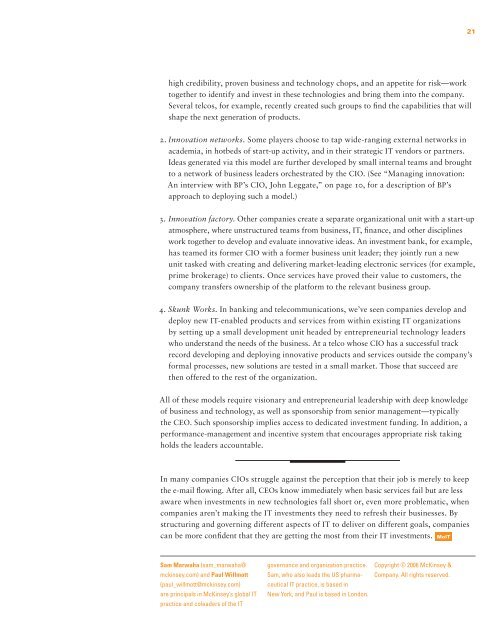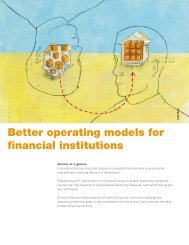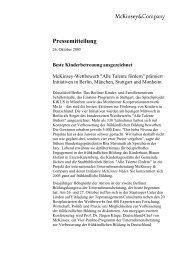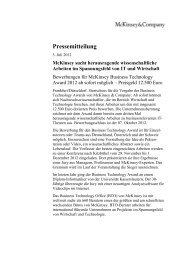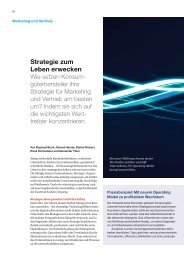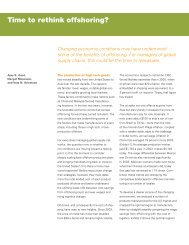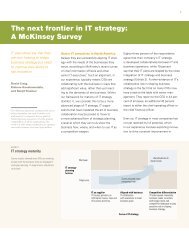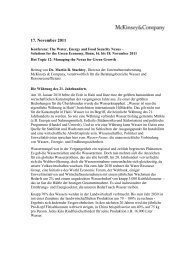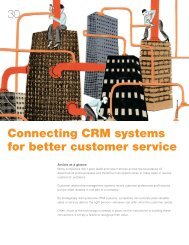Managing IT for scale, speed, and innovation - McKinsey & Company
Managing IT for scale, speed, and innovation - McKinsey & Company
Managing IT for scale, speed, and innovation - McKinsey & Company
You also want an ePaper? Increase the reach of your titles
YUMPU automatically turns print PDFs into web optimized ePapers that Google loves.
New <strong>IT</strong> leadership roles<br />
high credibility, proven business <strong>and</strong> technology chops, <strong>and</strong> an appetite <strong>for</strong> risk—work<br />
together to identify <strong>and</strong> invest in these technologies <strong>and</strong> bring them into the company.<br />
Several telcos, <strong>for</strong> example, recently created such groups to find the capabilities that will<br />
shape the next generation of products.<br />
2. Innovation networks. Some players choose to tap wide-ranging external networks in<br />
academia, in hotbeds of start-up activity, <strong>and</strong> in their strategic <strong>IT</strong> vendors or partners.<br />
Ideas generated via this model are further developed by small internal teams <strong>and</strong> brought<br />
to a network of business leaders orchestrated by the CIO. (See “<strong>Managing</strong> <strong>innovation</strong>:<br />
An interview with BP’s CIO, John Leggate,” on page 10, <strong>for</strong> a description of BP’s<br />
approach to deploying such a model.)<br />
3. Innovation factory. Other companies create a separate organizational unit with a start-up<br />
atmosphere, where unstructured teams from business, <strong>IT</strong>, finance, <strong>and</strong> other disciplines<br />
work together to develop <strong>and</strong> evaluate innovative ideas. An investment bank, <strong>for</strong> example,<br />
has teamed its <strong>for</strong>mer CIO with a <strong>for</strong>mer business unit leader; they jointly run a new<br />
unit tasked with creating <strong>and</strong> delivering market-leading electronic services (<strong>for</strong> example,<br />
prime brokerage) to clients. Once services have proved their value to customers, the<br />
company transfers ownership of the plat<strong>for</strong>m to the relevant business group.<br />
4. Skunk Works. In banking <strong>and</strong> telecommunications, we’ve seen companies develop <strong>and</strong><br />
deploy new <strong>IT</strong>-enabled products <strong>and</strong> services from within existing <strong>IT</strong> organizations<br />
by setting up a small development unit headed by entrepreneurial technology leaders<br />
who underst<strong>and</strong> the needs of the business. At a telco whose CIO has a successful track<br />
record developing <strong>and</strong> deploying innovative products <strong>and</strong> services outside the company’s<br />
<strong>for</strong>mal processes, new solutions are tested in a small market. Those that succeed are<br />
then offered to the rest of the organization.<br />
All of these models require visionary <strong>and</strong> entrepreneurial leadership with deep knowledge<br />
of business <strong>and</strong> technology, as well as sponsorship from senior management—typically<br />
the CEO. Such sponsorship implies access to dedicated investment funding. In addition, a<br />
per<strong>for</strong>mance-management <strong>and</strong> incentive system that encourages appropriate risk taking<br />
holds the leaders accountable.<br />
In many companies CIOs struggle against the perception that their job is merely to keep<br />
the e-mail flowing. After all, CEOs know immediately when basic services fail but are less<br />
aware when investments in new technologies fall short or, even more problematic, when<br />
companies aren’t making the <strong>IT</strong> investments they need to refresh their businesses. By<br />
structuring <strong>and</strong> governing different aspects of <strong>IT</strong> to deliver on different goals, companies<br />
can be more confident that they are getting the most from their <strong>IT</strong> investments. Mo<strong>IT</strong><br />
Sam Marwaha (sam_marwaha@<br />
mckinsey.com) <strong>and</strong> Paul Willmott<br />
(paul_willmott@mckinsey.com)<br />
are principals in <strong>McKinsey</strong>’s global <strong>IT</strong><br />
practice <strong>and</strong> coleaders of the <strong>IT</strong><br />
governance <strong>and</strong> organization practice.<br />
Sam, who also leads the US pharma-<br />
ceutical <strong>IT</strong> practice, is based in<br />
New York, <strong>and</strong> Paul is based in London.<br />
Copyright © 2006 <strong>McKinsey</strong> &<br />
<strong>Company</strong>. All rights reserved.


